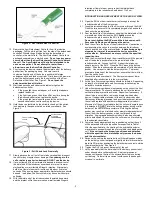
- 2 -
Figure 1
– Diagram of Azur System Setup
PREPARATION FOR USE
1.
Refer to Figure 1 for the set-up diagram.
2.
Attach a rotating hemostatic valve (RHV) to the hub of the guiding
catheter. Attach a 3-way stopcock to the side arm of the RHV
and then connect a line for continuous infusion of flush solution.
3.
Attach a second RHV to the hub of the microcatheter. Attach a 1-
way stopcock to the sidearm of the second RHV and connect the
flush solution line to the stopcock.
4.
Open the stopcock and flush the microcatheter with sterile flush
solution and then close the stopcock. To minimize the risk of
thromboembolic complications, it is critical that a continuous
infusion of appropriate sterile flush solution be maintained into the
guide catheter, the femoral sheath and the microcatheter.
CATHETERIZATION OF THE LESION
5.
Using standard interventional procedures, access the vessel with
a guide catheter. The guide catheter should have an inner
diameter (ID) large enough to allow for contrast injection while the
microcatheter is in place. This will allow for fluoroscopic road
mapping during the procedure.
6.
Select a microcatheter with the appropriate inner diameter. After
the microcatheter has been positioned inside the lesion, remove
the guidewire.
COIL SIZE SELECTION
7.
Perform fluoroscopic road mapping.
8.
Measure and estimate the size of the lesion to be treated.
9.
At the discretion of the physician, one or more Azur Framing Coils
(platinum 3D coils) may be used to establish an initial framework.
10. For aneurysm occlusion, the diameter of the first and second coils
should never be less than the width of the aneurysm neck or the
propensity for the coils to migrate may be increased.
11. For vessel occlusion, select a coil size that is slightly larger than
the vessel diameter.
12. Correct coil selection increases effectiveness and patient safety.
Occlusive efficiency is, in part, a function of compaction and
overall coil mass. In order to choose the optimum coil for any
given lesion, examine the pre-treatment angiograms. The
appropriate coil size should be chosen based upon angiographic
assessment of the diameter of the target or parent vessel,
aneurysm dome and aneurysm neck.
PREPARATION OF THE AZUR
SYSTEM FOR DELIVERY
Figure 2
– Azur Detachment Controller
13. Remove the Azur Detachment Controller from its protective
packaging. Pull the white pull-tab from the side of the detachment
controller. Discard the pull-tab and place the detachment






















